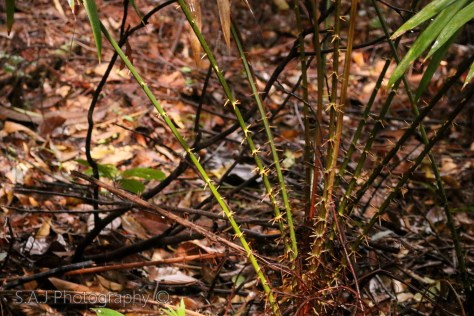Before we get into anything, what’s a woody liana? Liana (or Liane) is a woody plant that is rooted to the soil but which requires physical support from a neighbouring tree. Its weak stem and branches rely on other plants to reach the light. Since they are not self-supporting, their stems are narrow and flexible.
 (Credits: Rhett A. Butler)
(Credits: Rhett A. Butler)
Large lianas in a forest indicate that the forest consists of many matured trees and plants.
When a liana reaches the top of its host, it puts out searcher shoots to look for a taller support of suitable diameter. Searcher shoots can extend up to 2m from their last support; if they are not able to find another support, they fall over and will be replaced by another shoot. While most vines climb to the canopy with the help of taller supports, some vines climb up the stems of other vines attached in the canopy.
Once the liana reach the canopy, they begin to grow between the tree crowns. These bridges are very important to animals that cannot fly long distances. Without such bridges between crowns, these animals would have to descend to the ground where they are very vulnerable to predators. However, these connections also increase the possibility of trees pulling their neighbours along with them when they fall.
As liana grow over the trees that provide them physical support, they are the trees’ strong competitors for sunlight. In additional, since barely any resources are invested in making their stems and branches thicker, vines use a large amount of their resources to grow more leaves, and for reproduction. Since lianas grow very fast, it is to their disadvantage if they climb onto trees that are slow in growth.
Although lianas hinder forest regrowth in canopy gaps, many animals rely on them for the nutrition in their leaves, nectar, fruits, sap and pollen.
 (Credits: Dick Culbert)
(Credits: Dick Culbert)
Now, you might be wondering if there is any relationship between us and lianas. Indeed, we make use of lianas in a variety of ways; from providing fresh drinking water (vines are usually hollow, transport water through the liana) to producing poisons and drugs (curare, a chemical used for muscle relaxation and in arrow poisons by South American Indians is obtained from a type of liana). Indeed, vines are extremely useful to humans.
 (Credits: Wellcome Images )
(Credits: Wellcome Images )
I hope you have enjoyed reading about lianas as much as I enjoyed learning about them! Indeed, there is so much to learn about the flora around us!
Writer: Thang Hui Lin
References
Encyclopaedia Britannica. (2000, December 14). Liana. Retrieved from Encyclopaedia Britannica: https://www.britannica.com/plant/liana#accordion-article-history
Maheshwari, R. (2009). Structural characteristics of a giant tropical liana and its mode of canopy spread in an alien environment. Current Science , 58.
Putz, F. E. (2012). Vine Ecology. Retrieved from Ecology: http://www.ecology.info/vines.htm










